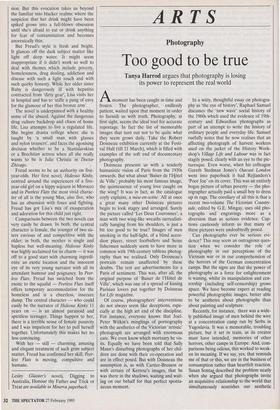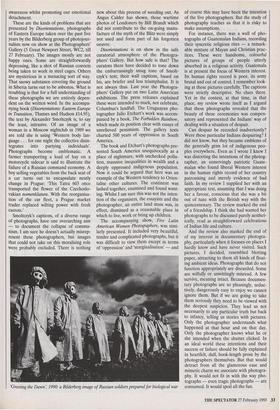ARTS
Photography
Too good to be true
Tanya Harrod argues that photography is losing its power to represent the real world
Amoment has been caught in time and frozen. The photographer, endlessly patient, waited upon that moment in order to furnish us with truth. Photography, at first sight, seems the ideal tool for accurate reportage. In fact the list of memorable images that turn out not to be quite what they seem grows daily. Take the Robert Doisneau exhibition currently at the Festi- val Hall (till 21 March), which is filled with examples of the soft end of documentary photography.
Doisneau presents us with a tenderly humanistic vision of Paris from the 1930s onwards. But what about 'Balser de ('Hotel de Ville', probably his most famous image, the quintessence of young love caught on the wing? It was in fact, as the catalogue coyly explains, a mise-en-scene. All at once a great many other Doisneau pictures begin to look stagey and arranged. Surely the picture called 'Les Deux Couronnes', a man with two wing-like wreaths surrealisti- cally hanging from his shoulders, is just a bit too good to be true? Images of men smoking in the half-light, of a blind accor- dion player, street footballers and Seine fishermen suddenly seem to have more in common with 19th-century tableau photog- raphy than we realised. Only Doisneau's portraits remain unaffected by these doubts. The rest are advertisements for a Paris of sentiment. This was, after all, the original purpose of `Balser de ('Hotel de Ville', which was one of a spread of kissing Parisiin lovers put together by Doisneau for Life magazine.
Of course, photographers' interventions do not always seem like deceptions, espe- cially at the high art end of the discipline. For instance, everyone knows that Joel- Peter Witkin's minglings of pornography with the aesthetics of the Victorian 'artistic' photograph are arranged with enormous care. We even know which mortuary he vis- its. Equally we have been told that Sally Mann's disturbing photographs of her chil- dren are done with their co-operation and are in effect posed. But with Doisneau the assumption is, as with Cartier-Bresson or with certain of Kertesz's images, that he was there in the shadows, waiting and wait- ing on our behalf for that perfect sponta- neous moment. In a witty, thoughtful essay on photogra- phy as 'the eye of history', Raphael Samuel discusses the 'new wave' social history of the 1960s which used the evidence of 19th- century and Edwardian photographs as part of an attempt to write the history of ordinary people and everyday life. Samuel ruefully notes that he now realises that an affecting photograph of harvest workers used on the jacket of the History Work- shop's Village Life and Labour was in fact stagily posed, clearly with an eye to the pic- turesque. Even worse, when his colleague Gareth Stedman Jones's Outcast London went into paperback it had Rejlanders's `Poor Joe' on its cover. This was an entirely bogus picture of urban poverty — the pho- tographer actually paid a small boy to dress up in rags. The corollary of all this is that a recent two-volume The Victorian Country- side, edited by G.E. Mingay, uses old pho- tographs and engravings more as a diversion than as serious evidence. Cap- tions cautiously inform us that many of these pictures were undoubtedly posed.
Can photographs ever be serious evi- dence? This may seem an outrageous ques- tion when we consider the role of photography in our perceptions of the Vietnam war or in our comprehension of the horrors of the German concentration camps. But the signs are that the power of photography as a force for enlightenment is waning, whilst its manipulation and cen- sorship (including self-censorship) grows apace. We have become expert at reading powerful photographic images, better able to be aesthetes about photographs than about painting and sculpture.
Recently, for instance, there was a wide- ly published image of men behind the wire at a concentration camp run by Serbs in Yugoslavia. It was a memorable, troubling picture, but it set in train, as its creator must have intended, memories of other horrors, other camps in Europe. And, com- parisons being odious, this worked to weak- en its meaning. If we say, yes, that reminds me of that or this, we are in the business of consumption rather than heartfelt reaction. Susan Sonta&described the problem neatly when she argued that photographs invite an acquisitive relationship to the world that simultaneously nourishes our aesthetic awareness whilst promoting our emotional detachment.
These are the kinds of problems that are presented by Disorientations, photographs of Eastern Europe taken over the past five years by the Bilderberg group of photojour- nalists now on show at the Photographers' Gallery (5 Great Newport Street, WC2, till 27 February). The images mostly are not happy ones. Some are straightforwardly depressing, like a shot of Russian convicts being taken to work in steel cages. Others are mysterious in a menacing sort of way. That snowy substance covering the ground in Siberia turns out to be asbestos. What is troubling is that for a full understanding of these photographs we are entirely depen- dent on the written word. In the accompa- nying book (Disorientations: Eastern Europe in Transition, Thames and Hudson £14.95), the text by Alexander Smoltczyk is, to say the least, intrusive. Of an image of a woman in a Moscow nightclub in 1989 we are told she is using 'Western body lan- guage . . for one night the collective disin- tegrates into partying individuals'. Photographs become emblematic. A farmer transporting a load of hay on a motorcycle sidecar is said to illustrate the failure of a Russian command economy. A boy selling vegetables from the back seat of a car turns out to encapsulate neatly change in Prague: 'This Tatra 603 once transported the flower of the Czechoslo- vakian nomenklatura. With the reorganisa- tion of the car fleet, a Prague market trader replaced wilting power with fresh carrots.'
Smoltczyk's captions, of a diverse range of photographs, have one overarching aim — to document the collapse of commu- nism. I am sure he doesn't actually misrep- resent these photographers, but images that could not take on this moralising role were probably excluded. There is nothing new about this process of weeding out. As Angus Calder has shown, those wartime photos of Londoners by Bill Brandt which did not contribute to the on-going manu- facture of the myth of the Blitz were simply not used and form part of his forgotten oeuvre.
Disorientations is on show in the safe curatorial atmosphere of the Photogra- phers' Gallery. But how safe is that? The curators there have decided to tone down the embarrassingly smug tone of Smolt- czyk's text; their wall captions, based on his, are briefer and less triumphalist. It is not always thus. Last year the Photogra- phers' Gallery put on two Latin American exhibitions. The press releases explained these were intended to mark, not celebrate, Columbus's landfall. The Uruguayan pho- tographer Julio Etchart's work was accom- panied by a book, The Forbidden Rainbow, which made its position clear with essays of unrelieved pessimism. The gallery texts charted 500 years of oppression in South America.
The book and Etchart's photographs pre- sented South America unequivocally as a place of nightmare, with unchecked pollu- tion, masssive inequalities in wealth and a deeply oppressed indigenous population. Now it could be argued that here was an example of the Western tendency to Orien- talise other cultures. The continent was lashed together, examined and found want- ing. Whilst I am sure this was not the inten- tion of the organisers, the essayists and the photographer, an entire land mass was, in effect, dismissed as a reasonable place in which to live, work or bring up children.
The accompanying show, Five Latin American Women Photographers, was simi- larly presented. It included very beautiful, tender and complicated photographs, but it was difficult to view them except in terms of 'oppression' and `marginalisation' — and 'Greeting the Dawn, 1990: a Bilderberg image of Russian soldiers prepared for biological war of course this may have been the intention of the five photographers. But the study of photography teaches us that it is risky to make assumptions.
For instance, there was a wall of pho- tographs of Guatemalan Indians, recording their syncretic religious rites — a remark- able mixture of Mayan and Christian prac- tices. These were handsome, colourful pictures of groups of people utterly absorbed in a religious activity. Guatemala is at present the focus of Western interest. Its human rights record is poor, its army brutal and out of control. I remember look- ing at these pictures carefully. The captions were strictly descriptive. No clues there. Yet in the context, at that time, in that place, my review wrote itself as I argued that these photographs revealed that the beauty of these ceremonies was compen- satory and represented the Indians' way of dealing with a situation of despair.
Can despair be recorded inadvertently? Were these particular Indians despairing? I did not know, but they became emblems of the generally grim lot of indigenous peo- ples everywhere. Even as I wrote I knew I was distorting the intentions of the photog- rapher, an unnervingly patriotic Guate- malan who found liberal Western interest in the human rights record of her country patronising and merely evidence of bad faith. In my review I supplied her with an appropriate text, assuming that I was doing her a favour, conscious that she was a bit out of tune with the British way with the quincentenary. The review marked the end of a friendship. I think she had wanted her photographs to be discussed purely aesthet- ically, read as straightforward celebrations of Indian life and culture.
And the review also marked the end of of my interest in documentary photogra- phy, particularly when it focuses on places I hardly know and have never visited. Such pictures, I decided, resembled blotting paper, attracting to them all kinds of float- ing ambient ideas. Photographs that do not function appropriately are discarded. Some are wilfully or unwittingly misread. A few survive, meaning intact. Because documen- tary photographs are so pleasingly, seduc- tively, dangerously easy to enjoy we cannot ignore them. But if we are going to take them seriously they need to be viewed with the deepest suspicion. They lead us not necessarily to any particular truth but back to infancy, telling us stories with pictures. Only the photographer understands what happened at that hour and on that day. Only the photographer knows what he or she intended when the shutter clicked. In an ideal world these intentions and their success or failure should be fully explained in heartfelt, dull, book-length prose by the photographers themselves. But that would detract from all the glamorous ease and mimetic charm we associate with photogra- phy. It would not fit in with the way pho- tographs — even tragic photographs — are consumed. It would spoil all the fun.



















































 Previous page
Previous page